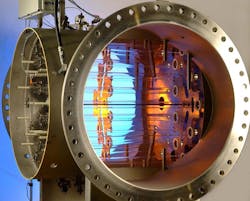Utilities and businesses require more effective water treatment technologies to meet evolving regulatory requirements. UV AOP efficiently treats a range of contaminants in various concentrations.
In the UV advanced oxidation process (UV AOP), UV light interacts with an oxidant to produce hydroxyl radicals that oxidize harmful compounds. Hydrogen peroxide, the most common oxidant, is injected upstream of the UV reactor in smaller concentrations for drinking water and typically larger concentrations for groundwater remediation. Pretreatment is often unnecessary, although metals such as iron and chromium may need to be removed.
Additionally, UV AOP is a vital technology wastewater treatment for potable reuse. However, chlorine may be more efficient at a lower pH treating RO permeate for potable reuse or with lower pH groundwater.
The cost-effectiveness of UV AOP is based on water quality, principally how well UV light travels through water. A computer model can simulate performance depending on water quality data, objectives, and other parameters. Additionally, a bench-scale design test or on-site pilot can treat a representative water sample to determine the best size and oxidant concentration for the full-scale design.
The most cost-effective contaminants for UV AOP include N-Nitrosodimethylamine (NDMA), 1,4-Dioxane, and vinyl chloride, and chlorinated solvents such as trichloroethylene (TCE).
UV AOP can also remove the taste and odor contaminants in drinking water and contaminants of emerging concern (CECs). UV AOP can mineralize contaminants to carbon dioxide, water, and mineral acids, yet the oxidation products of UV AOP are readily biodegradable and pose no toxicity or regulatory problems.
UV reactors are also used for drinking water disinfection. The design may include upsizing the reactor with two settings for disinfection and taste/odor control with hydrogen peroxide.
In some applications, a hybrid treatment system composed of UV AOP combined with traditional technologies such as GAC may prove most efficient. Expertise in various water technologies is essential. A trusted partner can examine treatment options and find the best solution when considering UV AOP technology.
Editor's Note: Scranton Gillette Communications and the SGC Water Group are not liable for the accuracy, efficacy and validity of the claims made in this piece. The views expressed in this content do not reflect the position of the editorial teams of Water & Wastes Digest, Water Quality Products and Storm Water Solutions.



